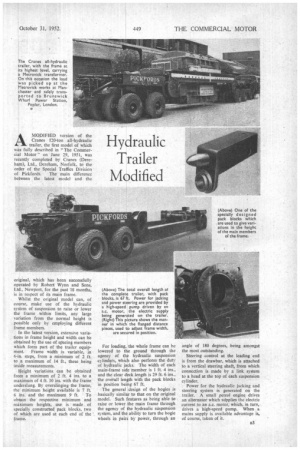Hydraulic Trailer Modified
Page 37

If you've noticed an error in this article please click here to report it so we can fix it.
AMODIFIED version of the Cranes 120-ton all-hydraulic trailer, the first model of which was fully described in The Commercial Motor" on June 29, 1951, was recently completed by Cranes (Dereham), Ltd., Dereham, Norfolk, to the order of the Special Traffics Division
of Pickfords. The main difference between the latest model and the original, which has been successfully operated by Robert Wynn and Sons, Ltd., Newport, for the past 18 months, is in respect of its main frame.
Whilst the original model can, of course, make use of the hydraulic system of suspension to raise or lower the frame within limits, any large variation from the normal height is possible only by employing different frame members.
In the latest version, extensive variations in frame height and width can be obtained by the use of spacing members which form part of the trailer equip ment. Frame width is variable, in 6-in, steps, from a minimum of 2 ft to a maximum of 14 ft., these being inside measurements_ Height variations can be obtained from a minimum of 2 ft. 4 ins, to a maximum of 4 ft. 10 ins. with the frame underslung. By overslinging the frame, the minimum height available is 7 ft 6 ins, and the maximum 9 ft. To obtain the respective minimum and maximum heights, use is made of specially construeted pack blocks, two of which are used at each end of the frame For loading, the whole frame can he lowered to the ground through the agency of the hydraulic suspension .cylinders, which also perform the duty of hydraulic jacks. The width of each main-frame side member is 1 ft. 4 ins., and the clear deck length is 29 ft. 6 ins., the overall length with the pack blocks in position being 67 ft.
The general design of the bogies is basically similar to that on the original model. Such features as being able to raise or lower the main frame through the agency of the hydraulic suspension system, and the ability to turn the bogie wheels in pairs by power, through an angle of 180 degrees, being amongst the most outstanding.
Steering control at the leading end is from the drawbar, which is attached to a vertical steering shaft, from which connection is made by a link system to a head at the top of each suspension cylinder.
Power for the hydraulic jacking and steering system is generated ort the trailer. A small petrol engine drives an alternator which sitpplies the electric current to an a.c. motor, which, in turn, drives a high-speed pump. When a mains supply is available advantage is, of course, taken of it.












































































